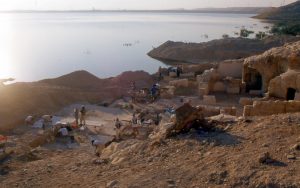Intervention
Bearing in mind that, during flooding, the structures had a greater possibility of survival if they still had their natural burial layers, the archaeologists were advised to limit excavation to the minimum of samples needed to understand the site’s topography or to study structures already partially exposed.
The conservators produced weekly work plans for the archaeologists in order to facilitate scheduling the archaeological investigation. These were based on a combination of data supplied by the dam company about the rising water and the time that would be needed for conservation, protection and reburial of excavated features.
The methods used in the intervention were as simple and rapid as possible in order to obtain maximum results in minimum time, given that the lake water was rising an average of 25 cm a day.
In the first phase, i.e. excavation, various preventive conservation operations were performed: for the mosaics, alternative routes were devised to avoid foot traffic, definitive discoveries were controlled (thin layer of earth left on surfaces for excavation together with cleaning), and surfaces were temporarily covered with geotextiles to retard evaporation.
In the second phase, exposure, activities revolved around consolidating areas and structures already excavated and preparing them for flooding. All operations in the various phases of excavation and exposure were implemented at the same time in different areas of the site: in the lower part while it was progressively reached by the water, and in the upper part with excavation in progress.
The conservation program involved the following operations:
· assistance to archaeologists during excavation to stabilize and clean the structures in order to facilitate clear reading of information and documentation;
· safety measures for excavation, stabilization and recovery of movable objects;
· documentation by castinging inscriptions and graffiti;
· detachment of mosaics that could not be left in situ because of their precarious condition or risks of exposure;
· conservation and protection of mosaics, frescoes and plasters with a sacrificial layer;
· planning and management of a reburial program for excavated areas;
· control and maintenance of the coastal area with water fluctuations.





















